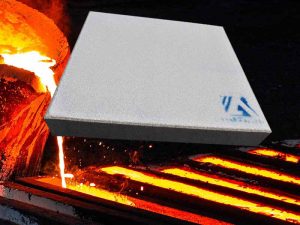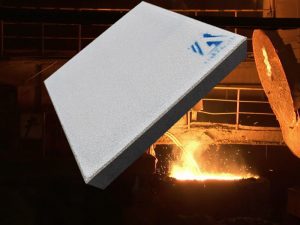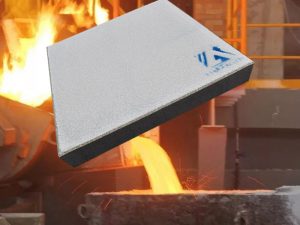Aluminum alloys for the aviation industry need degassing unit and ceramic foam filters
At 14:22 on July 24, 2022, China's Long March 5B Yaosan carrier rocket carrying the Wentian experimental module was ignited and launched on time at the Wenchang Space Launch Site in Hainan Province. About 495 seconds later, the Wentian experimental module and the rocket were successfully separated. , entered the predetermined orbit, and the launch was a complete success.
This is the 24th flight mission since the establishment of China's manned space project. The Wentian experimental module launched is the first scientific experimental module of the Chinese space station. It consists of a working cabin, an airlock cabin, and a resource cabin. It is used to support astronaut residency, outboard activities, and carry out space science experiments.
The Wentian experimental module launched by the Long March 5B in this "zero window" is the largest and heaviest "big guy" since China launched its aerospace industry. The quality of one carriage of the train is the same, and it is the heaviest single-cabin active aircraft currently in service in the world.
Among the metal materials used in the Wentian experimental cabin, according to mass estimation, aluminum alloy materials account for more than 75%. Among the metal materials used in rockets, except for a small number of titanium alloys and metal matrix composite materials, other materials are aluminum alloys. It is estimated that the aluminum alloys used in rockets account for about 95% of the total net mass of the metal structure.
Without aluminum, there would be no rocket industry as prosperous as it is today
China has become a global aerospace power and a primary power. In the meantime, aluminum materials produced by China Aluminum Group Northeast Light Alloy Co., Ltd., Southwest Aluminum (Group) Co., Ltd., and Northwest Aluminum Processing Co., Ltd. (hereinafter referred to as Dongqing, Southwest Aluminum, and Northwest Aluminum respectively) rushed to the rocket launch. In the process of space and spacecraft soaring into space, if there is no aluminum alloy structure, it will not fly into the sky like that, and successfully conduct scientific experiments with space. For example, in storage tanks for fuel - liquid hydrogen and liquid oxygen, all foreign countries, whether it is Japan, the United States, Russia, or the European Union, are welded with 2219 type aluminum alloy thick plates, and these storage tanks (boxes) are bundled. The ring parts and special-shaped ring parts together are also forged with 2219-type aluminum alloy.
China ranks at the world's advanced level in the field of manufacturing rocket storage tanks (boxes), rings, and upper and lower caps of storage tanks. The aluminum alloy thick plates used are made by Southwest Aluminum or Dongqing, and the rings are also provided by them. In addition to the forging process (also called rolling), it can also be manufactured by cutting-edge technology - the 3D printing process. The ring can be a relatively simple circular section or a rather complex special-shaped section.
In mid-April, Chongqing Science and Technology Bureau entrusted Chongqing Productivity Center to organize an expert group to "Develop and industrialize large-scale high-performance aluminum alloy special-shaped rings" for the "Technical Innovation and Application Development (Key R&D Industries)" project undertaken by Southwest Aluminum. Accepted and passed successfully. The project mainly carried out alloy modification design, ingot casting, billeting, ring rolling, heat treatment, and cold deformation technology research, in order to realize the integrated control of the formability of large and complex special-shaped ring parts, breaking through this kind of initiative. The integrated control of ring rolling and forming, as well as the simulation technology of rolling and forming large and complex special-shaped sections, the blanking process technology, the uniformity control technology, and the residual stress control technology, realize mass production and supply, economic benefits and The social benefits are remarkable, and the developed special-shaped ring forgings meet the requirements of major national projects. The successful implementation of this project of Southwest Aluminum has provided a solid theoretical foundation and practical experience for the rolling of large-scale special-shaped aluminum alloy rings filling the domestic gap and reaching the domestic leading and international advanced level.
2219 aluminum alloy excellent fuel and combustible tank material
The First Academy of China Aerospace Science and Technology Corporation is the cradle of launch vehicles, and the latest Long March 5 launch vehicle is their new work. In the early stage of space development, the United States used the 2014 alloy (equivalent to China's LD alloy), which has good formability and can be processed into various materials required by rockets, such as thick plates, extrusions, and forgings. Later, due to the advent and maturity of automatic welding technology, 2219 aluminum alloy (equivalent to LY16 in China) was used. Now no matter which country, the liquid fuel (liquid hydrogen) and the accelerant tank (liquid oxygen) of the rocket are welded with 2219 alloy because it has a series of general advantages of aluminum alloy, as well as excellent low-temperature performance. The various properties of the alloy rise synchronously with the decrease of temperature, and it is also a heat-resistant alloy. Even if the working temperature is as high as 300 ℃, it still has a very high strength performance, which is a very valuable performance, thus becoming a long-term Prosperous rocket and spacecraft aluminum alloy.
Alloy 2219 is a fairly old aluminum alloy. It was invented in the mid-1930s. It was invented by the Pittsburgh Research Center of Alcoa. It was registered with Alcoa in 1954 and has now developed into 4 members. It can be processed into various semi-finished products, and the material states are O, T42, T31, T351, T37, T62, T81, T851, and T87. The original 2019 alloy and 2119 alloy were eliminated.
2219-T62 alloy is a kind of Al-Cu-Mn-Ti-V-Zr alloy. Copper is the main alloying element. The main purpose of adding Cu to Al is to improve the strength. The increase of low-temperature strength is by heat treatment. The increase in high-temperature strength is through the compounds formed by Cu and Mn, Ti, V, Zr, etc. These compounds have the effect of refining grains, microstructure, and improving alloy properties. Cu reduces the electrode potential of Al and also reduces its corrosion resistance. Al-Cu alloys have a serious pitting corrosion tendency in the annealed state, that is, O state alloys, but after age hardening, they are sensitive to grain boundary corrosion or stress corrosion. There is copper atom segregated clusters in the Al-Cu alloy melt with a diameter of (40~100)×10-10m. Eutectic Reaction of Aluminum Termination: Melt - Al+Al2Cu, 820K, 33.2%Cu. Al2Cu is often referred to as the theta phase, which is a tetragonal crystal system crystallized directly from the melt at 53.3%Cu and 864K, and there are 12 atoms in a unit cell.
Among the aluminum alloys, the 2219 alloy is the densest, and it is also the densest among the rocket aluminum alloys. The density of the main aluminum alloys of the rocket structure: 2219 alloy is 2.84g/cm3, 7075 alloy is 2.80g/cm3, and 2014 alloy is 2.80g/cm3.
Other physical properties of rocket aluminum alloy: the average thermal expansion coefficient of 20 ℃ ~ 100 ℃, 2219 alloy is 22.5μm/(m·k), 2014 alloy is 22.5μm/(m·k), 7075 alloy is 23.4μm/( m k); melting temperature: 2219 alloy liquidus temperature 643 ℃, solidus temperature 543 ℃, 2014 alloy melting temperature range 507 ℃ ~ 638 ℃, 7075 alloys without homogenization treatment ingot or without solid solution The eutectic temperature of the processed material is 477 °C ~ 635 °C, the initial melting temperature of the homogenized ingot and the solution-processed material is 532 °C; 960J/(kg·k).
The machinability of the 2219 alloy is good, it is the best among aluminum alloys, and the material in the O state is slightly worse; it has good weldability, but materials in all states cannot be brazed, and materials in the O state cannot be gas welded. Welding and seam welding is not easy, and gas welding, spot welding, seam welding, and argon arc welding are possible in other states. When 2219 alloy workpieces are connected to each other, it is better to use 2319 alloy as filler metal, which is more beneficial to the strength, plasticity, and corrosion resistance of the weld. When welding with other materials, 4043 alloys should be used as welding wire to reduce welding cracks. 2219 alloy Although it can be welded, the corrosion resistance of the weld is low.
Due to the high content of Cu, the 2219 alloy has poor corrosion resistance, which is worse than that of the 2024 alloy and cannot be used under unprotected conditions. However, the time from the manufacture of each rocket to the launch of each rocket is very short, and the poor corrosion resistance is not bad for the launch. When used in other occasions, the plate can be clad with aluminum, and a clad material containing a small amount of zinc should be used. However, due to the high content of copper in the matrix, which is easy to diffuse, the protective effect is reduced, and it is not as good as the 2024 alloy. The extruded material in the T4 state has a tendency to stress corrosion cracking. The corrosion resistance of the weld transition zone is also very low, so it must be protected by anodizing or painting.
The 2014 alloy Al-Mg-Si-Cu series has the same composition as the 2017 alloy except that the content of Mn and Si is slightly higher. The characteristics of the alloy are: high strength, comparable to 2024 alloy, but the hot cracking tendency of the ingot is smaller than that of 2024 alloy, better thermoplasticity, better heat resistance and better weldability; However, the longitudinal and lateral properties of the materials are quite different, and the artificial aging state has the tendency of intergranular corrosion and stress corrosion cracking. It is used in the manufacture of welded parts in rocket and spacecraft structures. In terms of performance and other aspects, it is also a good rocket aluminum alloy.
The main phase composition of 2014 alloy: α (Al), Mg2Si, θ (Al2Cu), S (Al2CuMg), W (Al4Cu4Mg5Si4), impurity phase Al5 (FeMnSi), etc. Mg and Si form the main strengthening phase Mg2Si, and the main role of Cu is to form θ, S, and W phases, which play a supplementary strengthening role and can inhibit the parking effect of Al-Mg-Si alloys. Copper also improves hot workability, suppresses extrusion effects, and reduces manganese-induced anisotropy in the alloy. Manganese can refine recrystallized grains and expand the upper limit of quenching heating temperature, thereby increasing the solid solubility of alloying elements and improving the effect of aging strengthening. Titanium can refine the casting structure, and iron can prevent the growth of recrystallized grains during quenching and heating, but when it exceeds 0.8%, a coarse Al6 (FeMn) phase will appear, reducing the plasticity of the alloy. Zinc is an impurity and should be controlled.
The machinability of the 2014 alloy is good, but the O state is slightly worse. Other states can be dry cut. If high surface quality is required, kerosene or 50% kerosene-lard mixed oil can be used as cutting fluid. The alloy cannot be gas welded and brazed but can be hydrogen arc welded and spot welded. Usually, its own material or 2017 alloy is used as the filler metal, and the strength of the weld can be improved by re-heat treatment. Using the same heat treatment process before welding, the tensile strength of the transverse welding can reach about 80% of the matrix, and the plasticity is reduced more. The 2014 alloy is prone to welding cracks. If the LT1 electrode is used, the crack tendency can be reduced. Due to its high strength and heat resistance, and no low-temperature brittleness, the alloy can be used to weld large rocket fuel tanks.
Due to the high copper content of the 2014 alloy, the corrosion resistance is not good, and there is a tendency for intergranular corrosion and stress corrosion cracking, but it is related to the heat treatment state and the thickness of the workpiece section. Corrosion resistance is better than in thick sections. Due to the thick section of the workpiece, rapid cooling cannot be obtained during quenching, which is unfavorable for the precipitation of the second phase.
The melting temperature of the 2014 alloy is 700℃~750℃, the casting temperature is 700℃~730℃, the homogenization annealing temperature is 495℃, the extrusion temperature is 380℃~450℃, the forging temperature is 380℃~480℃, the annealing temperature is 470℃, and the solid melting The processing temperature is 502℃±3℃, and the overburning temperature is 515℃. Aging specification: natural aging is more than 10d, artificial aging is 160℃±5℃, 10h, but forgings are 170℃±5℃, 10h.
Alloy 7075 is an Al-Zn-Mg-Cu ultra-high-strength aluminum alloy, which is characterized by high strength, good heat treatment strengthening effect, and medium plasticity in annealed and newly quenched states. The corrosion resistance is better than that of natural aging materials, and the natural aging process is slow, and it takes 3 months to reach the peak of aging hardening, so they are all used in the artificial aging state. Stress corrosion cracking tendency.
Its main phase composition: α (Al), η (MgZn2), T (Al2Mg3Zn3), S (Al2MgCu), and possible impurity phases are Mg2Si, Al6 (FeMn), Al (FeMn) Si, etc. Zinc and magnesium form the main strengthening phases η and T, and they have large solubility in aluminum, so the heat treatment effect is strong. The strength of Al-Zn-Mg alloys increases with the increase of Zn and Mg contents, but the stress corrosion susceptibility also increases simultaneously. The addition of Cu, Mn, and Cr can improve corrosion resistance. Cr has the greatest effect, and the addition of <0.3% has a significant effect, followed by the effect of Mn, but Mn and Cr can improve the quenching sensitivity of the alloy. Cu can not only improve the corrosion resistance of the alloy, but also form the θ phase, which plays a supplementary strengthening role, but it is not good for weldability. Fe and Si are harmful impurities, especially for fracture toughness.
The 7075 alloy in the quenched and aged state or in the cold working state has good machinability, and the O state material is not good. High-speed steel or cemented carbide tools should be used, and have a large rake angle, which can be used for dry cutting. It is best to use kerosene or a 50% kerosene-lard mixture as the cutting fluid.
7075 alloy has high welding sensitivity, cracks easily occur during fusion welding, and the weld's mechanical properties and stress corrosion cracking resistance is also very poor. Even if the strength properties are mostly recovered by heat treatment, the elongation is still very low, so it cannot be melted Welding, but contact welding is still possible with a strong pulse current. Therefore, it is usually connected by riveting or gluing.
7075 alloy generally has good corrosion resistance, but poor resistance to stress corrosion cracking. Shot peening, aluminum coating, graded aging, deformation heat treatment, etc. are all beneficial to reduce the tendency of stress corrosion cracking. The melting temperature of the alloy is 720℃~750℃, the casting temperature is 715℃~730℃, the hot rolling temperature is 370℃~410℃, the forging temperature is 380℃~450℃, the extrusion temperature is 300℃~450℃, and the annealing temperature is 360℃~ 420℃, annealing cooling rate ≤30℃/h, slow cooling to 150℃ and then air cooling. The solution treatment temperature is 470℃±5℃, and the quenching transfer time is less than or equal to 15s, otherwise, the supersaturated solid solution is easy to decompose. The residence time after quenching has an impact on the effect of artificial aging in the future. It should be artificially aged within 4h or after 48h after quenching, otherwise, the strength will decrease.
Therefore, 7075 alloy is one of the most widely used aerospace aluminum alloys.
Alloys are one of the most important metals in the aerospace industry and the purity of aluminum determines the strength of alloys. So compared to purchasing aluminum billets, usually high-end alloy casting companies will purify aluminum by themselves. So most of them will use aluminum degasser(also called the degassing unit) and refining fluxes, and the ceramic foam filter to purify aluminum. AdTech focus on purification machines and materials for many years and will provide a one-stop solution for high-end alloy casting companies.





